人教版英语九年级教案
人教版英语九年级全册unit1-2教案

人教版英语九年级全册unit1-2教案Unit 1-2 Teaching Plan for 9th Grade English TextbookUnit 1: Our School Life1. Teaching Objectives:- Students will be able to talk about their daily school life activities.- Students will be able to use the present simple tense to talk about habits and routines.- Students will be able to ask and answer questions about school life.2. Key Vocabulary:- Subjects: Math, English, Science, History, Geography- Activities: study, read, write, listen, speak, play, do, have, eat- Other: classroom, library, playground, lunch break,after-school activities3. Teaching Activities:- Lead a discussion on students' daily school life activities.- Introduce vocabulary and practice pronunciation.- Discuss routines and habits using the present simple tense.- Role-play asking and answering questions about school life activities.- Present a short video or audio clip of a typical school day.- Have students create a daily schedule for themselves and share with the class.4. Assessment:- Quizzes on vocabulary and grammar usage.- Oral presentations of daily schedules.- Written assignments on describing school life activities.Unit 2: The World Around Us1. Teaching Objectives:- Students will be able to talk about different countries and cultures.- Students will be able to use adjectives to describe places and people.- Students will be able to use comparative and superlative forms.2. Key Vocabulary:- Countries: China, Japan, France, Brazil, Australia- Adjectives: beautiful, crowded, modern, traditional, diverse- Comparative and Superlative Forms: bigger, more crowded, most diverse3. Teaching Activities:- Introduce the countries and their cultures through pictures and videos.- Discuss the adjectives used to describe different places and people.- Practice using comparative and superlative forms in sentences.- Have students work in pairs to compare two countries of their choice.- Conduct a class debate on the best country to visit based on the criteria discussed.4. Assessment:- Quizzes on vocabulary and grammar structures.- Written assignments comparing two countries.- Oral presentations on a chosen country's culture and attractions.Overall, the teaching plan for Unit 1-2 of the 9th-grade English textbook focuses on developing students' language skills in talking about daily routines and school life activities, as well as describing different countries and cultures. Through a variety of vocabulary and grammar exercises, as well as interactive activities and discussions, students will be engaged and motivated to learn English in a fun and meaningful way.。
九年级英语教案及反思全一册人教版
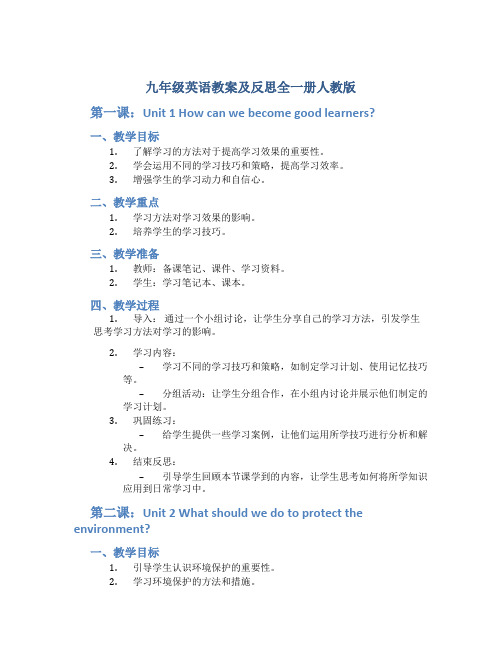
九年级英语教案及反思全一册人教版第一课:Unit 1 How can we become good learners?一、教学目标1.了解学习的方法对于提高学习效果的重要性。
2.学会运用不同的学习技巧和策略,提高学习效率。
3.增强学生的学习动力和自信心。
二、教学重点1.学习方法对学习效果的影响。
2.培养学生的学习技巧。
三、教学准备1.教师:备课笔记、课件、学习资料。
2.学生:学习笔记本、课本。
四、教学过程1.导入:通过一个小组讨论,让学生分享自己的学习方法,引发学生思考学习方法对学习的影响。
2.学习内容:–学习不同的学习技巧和策略,如制定学习计划、使用记忆技巧等。
–分组活动:让学生分组合作,在小组内讨论并展示他们制定的学习计划。
3.巩固练习:–给学生提供一些学习案例,让他们运用所学技巧进行分析和解决。
4.结束反思:–引导学生回顾本节课学到的内容,让学生思考如何将所学知识应用到日常学习中。
第二课:Unit 2 What should we do to protect the environment?一、教学目标1.引导学生认识环境保护的重要性。
2.学习环境保护的方法和措施。
3.激发学生爱护环境的意识。
二、教学重点1.环境保护的重要性。
2.环境保护的具体措施和方法。
三、教学准备1.教师:备课笔记、PPT、环保素材。
2.学生:学习笔记本、环保手册。
四、教学过程1.导入:通过一个视频或图片展示,引发学生思考环境污染对人类生活的影响。
2.学习内容:–学习环境保护的相关知识,了解环境污染的来源和危害。
–分组讨论:让学生分组探讨如何保护环境并提出解决方案。
3.实践活动:–组织学生参加环境保护实践活动,如垃圾分类、植树等,让学生亲身体验环保行动的重要性。
4.总结反思:–引导学生总结本节课学到的环保知识,让学生思考日常生活中如何做出环保实践。
总结与展望本节课通过引导学生探讨学习方法和环境保护,旨在培养学生的学习能力和环保意识,帮助他们成为全面发展的人才。
人教版九年级英语教案

人教版九年级英语教案一、教学目标。
1. 语言知识目标。
- 学生能够掌握本单元的重点单词,如“influence”“require”“silent”等,并能准确发音、拼写和运用。
- 理解并熟练运用重点短语和句型,如“be influenced by”“require sb. to do sth.”等。
2. 语言技能目标。
- 听力方面,能听懂有关人物性格变化及其原因的对话和短文。
- 口语方面,能够用英语流利地描述人物的性格特点以及这些特点形成的原因。
- 阅读方面,能读懂关于个人成长和性格发展的文章,掌握文章的主要内容和细节信息,并能根据文章进行简单的推理。
- 写作方面,能够根据所给话题,写出一篇关于人物性格变化的短文,内容完整,语言表达准确。
3. 情感态度目标。
- 让学生意识到成长过程中各种因素对性格的影响,鼓励学生积极面对生活中的变化,培养积极向上的人生态度。
4. 文化意识目标。
- 了解不同文化背景下人们性格形成的差异,拓宽国际视野。
二、教学重难点。
1. 教学重点。
- 重点单词、短语和句型的学习与运用。
- 掌握描述人物性格变化的表达方式。
2. 教学难点。
- 如何引导学生理解并运用较复杂的句子结构,如含有定语从句的句子来描述人物性格变化的原因。
- 让学生在口语和写作中准确地表达自己的观点,并使内容富有逻辑性。
三、教学方法。
1. 情景教学法。
通过创设各种与生活实际相关的情景,让学生在真实的语境中学习和运用英语。
例如,创设一个同学聚会的情景,让学生描述多年不见的同学性格上的变化。
2. 任务驱动法。
布置各种任务,如小组讨论、角色扮演、短文写作等,让学生在完成任务的过程中提高语言综合运用能力。
3. 交际教学法。
鼓励学生之间、学生与教师之间进行英语交流,培养学生的口语表达能力和交际能力。
四、教学过程。
(一)导入(5分钟)1. 老师走进教室,脸上带着神秘的笑容,然后说:“Hey, guys! Today we are going to embark on an interesting journey about how people change. You know, just like a caterpillar turns into a beautiful butterfly. Let's first lookat some pictures.”(展示一些名人小时候和长大后的对比照片,如周杰伦、哈利·波特扮演者丹尼尔·雷德克里夫等)2. 接着问学生:“Can you see any differences in their looks? And what about their personalities? Do you think they have changed?”引导学生简单讨论并分享自己的看法。
人教版九年级上册英语教案(优秀5篇)
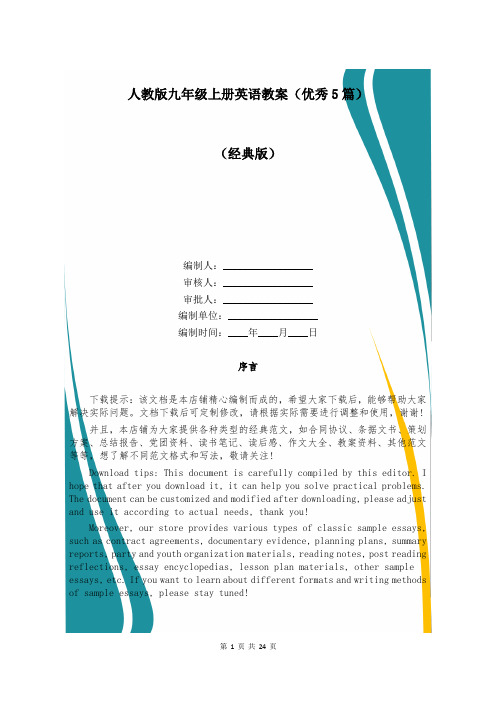
人教版九年级上册英语教案(优秀5篇)(经典版)编制人:__________________审核人:__________________审批人:__________________编制单位:__________________编制时间:____年____月____日序言下载提示:该文档是本店铺精心编制而成的,希望大家下载后,能够帮助大家解决实际问题。
文档下载后可定制修改,请根据实际需要进行调整和使用,谢谢!并且,本店铺为大家提供各种类型的经典范文,如合同协议、条据文书、策划方案、总结报告、党团资料、读书笔记、读后感、作文大全、教案资料、其他范文等等,想了解不同范文格式和写法,敬请关注!Download tips: This document is carefully compiled by this editor. I hope that after you download it, it can help you solve practical problems. The document can be customized and modified after downloading, please adjust and use it according to actual needs, thank you!Moreover, our store provides various types of classic sample essays, such as contract agreements, documentary evidence, planning plans, summary reports, party and youth organization materials, reading notes, post reading reflections, essay encyclopedias, lesson plan materials, other sample essays, etc. If you want to learn about different formats and writing methods of sample essays, please stay tuned!人教版九年级上册英语教案(优秀5篇)九年级是整个初中阶段的重要一年,因此教师需要学习先进的教育理念,认真准备每一次教案。
新人教版九年级英语上册全册教案
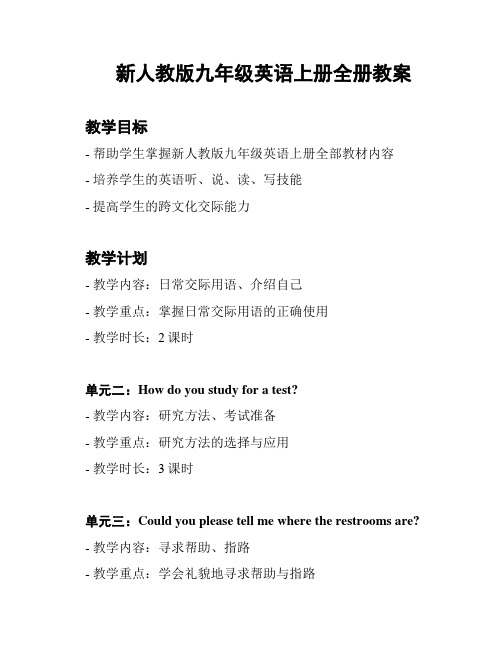
新人教版九年级英语上册全册教案教学目标- 帮助学生掌握新人教版九年级英语上册全部教材内容- 培养学生的英语听、说、读、写技能- 提高学生的跨文化交际能力教学计划- 教学内容:日常交际用语、介绍自己- 教学重点:掌握日常交际用语的正确使用- 教学时长:2课时单元二:How do you study for a test?- 教学内容:研究方法、考试准备- 教学重点:研究方法的选择与应用- 教学时长:3课时单元三:Could you please tell me where the restrooms are? - 教学内容:寻求帮助、指路- 教学重点:学会礼貌地寻求帮助与指路- 教学时长:2课时单元四:I used to be afraid of the dark.- 教学内容:过去的经历和惯- 教学重点:掌握过去式的使用- 教学时长:2课时单元五:What are the benefits of going green?- 教学内容:环境保护、可持续发展- 教学重点:理解环境保护的重要性- 教学时长:3课时单元六:I love music that I can dance to.- 教学内容:音乐、电影与艺术- 教学重点:学会表达自己对音乐、电影和艺术的喜好和感受- 教学时长:2课时单元七:Teenagers should be allowed to choose their own clothes.- 教学内容:青少年的权利与责任- 教学重点:理解和讨论青少年应有的权利与责任- 教学时长:3课时单元八:Reading for pleasure- 教学内容:阅读和写作- 教学重点:培养学生的阅读兴趣和写作能力- 教学时长:4课时单元九:Wildlife protection- 教学内容:野生动物保护- 教学重点:了解野生动物保护的重要性,并表达自己的看法- 教学时长:2课时单元十:Musical instruments- 教学内容:乐器与音乐- 教学重点:了解各种乐器和音乐类型,并能进行简单的介绍- 教学时长:3课时教学评价- 结合课堂表现、作业成绩、测试等多种评价方式进行评价- 通过个人表现、小组合作等方式培养学生的主动研究能力- 鼓励学生参与课堂互动,提高口语表达能力参考资料- 教材:新人教版九年级英语上册- 辅助教材:听力材料、课外阅读材料等。
人教版九年级英语上册教案(全册)
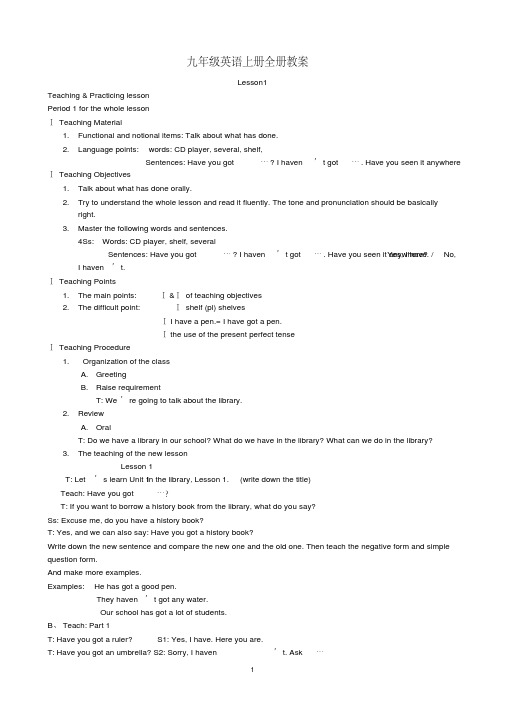
九年级英语上册全册教案Lesson1Teaching & Practicing lessonPeriod 1 for the whole lessonⅠ Teaching Material1.Functional and notional items: Talk about what has done.nguage points: words: CD player, several, shelf,Sentences: Have you got …? I haven’t got …. Have you seen it anywhere Ⅰ Teaching Objectives1.Talk about what has done orally.2.Try to understand the whole lesson and read it fluently. The tone and pronunciation should be basicallyright.3.Master the following words and sentences.4Ss: Words: CD player, shelf, severalYes, I have. / No, Sentences: Have you got …? I haven’t got …. Have you seen it anywhere?I haven’t.Ⅰ Teaching Points1.The main points: Ⅰ&Ⅰ of teaching objectives2.The difficult point:Ⅰ shelf (pl) shelvesⅠI have a pen.= I have got a pen.Ⅰthe use of the present perfect tenseⅠ Teaching Procedureanization of the classA.GreetingB.Raise requirementT: We’re going to talk about the library.2.ReviewA.OralT: Do we have a library in our school? What do we have in the library? What can we do in the library?3.The teaching of the new lessonLesson 1T: Let’s learn Unit 1 In the library, Lesson 1. (write down the title)Teach: Have you got …?T: If you want to borrow a history book from the library, what do you say?Ss: Excuse me, do you have a history book?T: Yes, and we can also say: Have you got a history book?Write down the new sentence and compare the new one and the old one. Then teach the negative form and simple question form.And make more examples.Examples: He has got a good pen.They haven’t got any water.Our school has got a lot of students.B、Teach: Part 1T: Have you got a ruler? S1: Yes, I have. Here you are.T: Have you got an umbrella? S2: Sorry, I haven’t. Ask …Ask the Ss to use Part 1 to make new dialogue in pairs and then ask some to do it in front of the class. Teach player” at the same time.B.Teach: severalT: Have you got a pen? How many pens have you got?S1: FiveT: We may also say: “You’ve got several pens.”Write down the word: severalB.Teach: shelfT: Just now we talked about the library, we know there are many books in the library. Where are the books put? Teach: on the shelf shelf (pl) shelvesB.Part2T: Now I’d like you to make a dialogue talking about borrowing books about different subjects.Do it in pairs first then ask some to do it.Analysis: books about … at the moment = now = right nowB.Part 3Dialogue 1Listen and answer: Well, when you borrow books from the library, you must be careful, but Jim is not careful. What happened? Where was the book?Then read it and learn the dialogue.Analysis: Have you seen it anywhere? ( tense and the use of anywhere)Dialogue 2Listen and answer: How about Tom? What has he lost? Where was it?Read and learn.Analysis: have lost (tense)Perhaps he’s seen it. ( ‘s is short for has)I saw it on Lin Tao’s desk five minutes ago. ( tense)B. Conclusion1. have got = have 2 several = a few 3.on the shelf 4. the present perfect tenseA.Wb. Ex1 &24.Homework1.Do Wb. Ex 3&42.Recite Part 3Lesson 2Reading lesson2 periods for Lesson 2ⅠTeaching Materialsnguage points:Words: already, yard, schoolyard, step, librarian, probably, pay, sadly, mark, bookmarkPhrases: used to, put down, pay for, come up withSentences: Her hobby is reading.So was the librarian.Now her lost books are usually returned to the library.ⅠTeaching Objectives1.Read the whole lesson and try to understand its content. Make sure to answer the questions in Wbcorrectly.2.Read the lesson fluently, the pronunciation and tone should be right.Ⅰ Teaching Points1.The main points---(1)&(2) in teaching objectives2.The difficult pointsA: already, “al” makes an / / soundB: the difference between “on” and “about”C: make sb. + adj.D: used to do sth.E: come up with an idea= think of an ideaPeriod 1Ⅰ Teaching Procedureanization of the classT: Today we are going to Lesson 2, in Lesson 2, we are going to talk about the library.2.ReviewT: Before we learn the new lesson, let’s go over what we learned yesterday.A.OrallyHave = have got eg. They don’t have any shelves.= They haven’t got any shelves.Has = has got eg. Does he have a CD player?= Has he got a CD player?Several=a fewOn the shelfThe construction and concept of the present perfect tenseB.Recite Part 2C.Wb. Ex33.The teaching of the new lessonA.Lesson 2T: We know we can borrow books from a library. But if we lose the books, what should we do? Letgo on to learn Lesson 2, we will know the answer in it.( write down Lesson 2)B.pay forWell, you should pay for it.Teach: pay, paid, paidPay for : give money to sb. for sth.C.onT: Why do people like to go to the library?T: Because there are books on many different subjects.D.knowledgePeople can learn much knowledge from them.E.Part 1 Pre-readF.Part 2Ask the Ss the read the passage and answer questions in their Wb. Ex 1G.Read and learnParagraph 1T: How old is the writer’s grandma?What was she?What is her hobby?Why does she love books?4.Homework.A. Read the end of the text and finish the exercises in Wb.Junior English for ChinaBook 3Lesson 3课型:讲练课ⅠTeaching Materials1.Functional and notional itemsAsk questions about something has donenguage MaterialsWords: encourage, once, abroad, copyPhrases: think of, encourage sb. to do sth., get sth. back, pick upSentences: Have you ever been abroad? Yes, just once.I’ve just cleaned the kitchen.Really? I did that hours ago.Grammar: The difference between the present perfect tense and the past indefinite tenseⅠTeaching Objectives1.Learn to ask questions about something has done2.Read the whole lesson fluently, and pronunciation and intonation should be right.3.Master the following materials(4 skills) Words: once, copyPhrases: think of, pick upSentences: Have you been abroad? Yes, only once.(3 skills) Words: encourage, abroadPhrases: get sth. back, be abroadⅠ Teaching Points1.The main points: (1)&(2) in teaching objectives2.The difficult points:A.“ever, just, already”, they should be put in the middle of “ have done”B. The difference between the present perfect tense and the past indefinite tenseⅠ Teaching Procedureanization of the class2.RevisionBefore we go on to learn the new lesson, let’s go over what we learn in Lesson 2.A.OralGrandma lost library books. If she really lose them, what should she do?Did the librarian have any ideas? What is it?What did they doB. Workbook Ex23.The teaching of the new lessonA.Lesson 3Can Grandma get all her lost books back? Let’s go on to learn Lesson 3.B.Read Part 1 and answer the following questions:Did Grandma get all her lost books back?How did she get them back?C.Read and learn*Think of:认为、想起、想出Eg: What do you think of it?I often think of my friends in Beijing.*Encourage sb. to do sth.Eg. The teacher thought a lot about how to encourage his students to study hard.*Pick up: pick it\them up*return sth. to sb.*get sth. from sb.D.Reading practiceE.Retell the storyF.Ask and answerHave you ever picked up a library book? Yes, I have\ No, I haven’t.Ask the students to ask and answer in pairs by using Part 2 and ask some to do it in class.Teach: abroad, onceDo Wb. Ex1G.Part 3Play and English songT: Have you ever listened to foreign music?Ss: Yes, we have.T: And we have just listened to it.Make sentences by using “ I have just…”Read and learnTeach: copyPoint out the difference between the present perfect tense and the past indefinite tense.The present perfect tense shouldn’t be used together with the past time.H.Conclusionthe use of “ever, just, already” in the present perfect tensethe difference between the present perfect tense and the past indefinite tense4.HomeworkA.Wb. EX2&3B.Go over the language pointsLesson 4课型:练习课ⅠTeaching Materialsnguage MaterialsWords: spoil, as, screenPhrases: on the computer, find outSentences: I guess somebody else has borrowed it.Could you find out who has taken it?Grammar: The present perfect tenseⅠTeaching Objectives4.Read the whole lesson fluently, and pronunciation and intonation should be right.5.Learn to read the information on the library cards and the computer screen.6.Master the following materials(4 skills) Word: asphrase: on the computer, find out(3 skills) Words: spoil, screenⅠ Teaching Points3.The main points: (1)&(2) in teaching objectives4.The difficult points: learn to read the information on the library cards and the computer screenⅠ Teaching Procedureanization of the classToday, we are going to learn Lesson 4. In Lesson 4, we’re going to talk about the information on thelibrary cards and the computer screen.6.RevisionBefore we go on to learn the new lesson, let’s go over what we learn in Lesson 3.A.OralHow could Grandma get all her lost books back?the use of the adverbs in the present perfect tense.7.The teaching of the new lessonA.Lesson 4Yesterday, we learned that grandma usually borrowed books from the library. There is a new librarytoday. If you want to read books, how can you find them? Let’s go on to learn Lesson 4.B.Part1I’d like you to listen and do Wb. Ex.1C.Part 2Ask the students to write down something about the school librarian and report it to the class. Teach:as He works there as a shop assistant.D.Part 4Learn to read the information on the cards and the computer screen.E.Part 3Listen and answer: What does the boy want to borrow?What’s its name?Who has borrowed it?Read and learn.has borrowed, has taken, has got( the present perfect tense)find outRead and act.F.Part 5Read and learn.G.Checkpoint 1H.Wb. Ex.2&58.HomeworkA.Wb. Ex 3B.Go over the whole unit.Lesson 5课型:讲练课ⅠTeaching Materials4.Functional and notional itemsA. Learn to ask how long sb. has done sth.B. Learn to talk about if someone has been to a place.nguage MaterialsWords: surf, surfing, surfer, wave, Hawaii, beach, twice, Bondi, none, Newquay, water-ski, canoe Phrases: have a try, since last Wednesday, learn sth. from sb. how to do it, several timesSentences: What’s …like?How long have you been in Sydney?Have you ever been to …?Grammar: the present perfect tenseⅠTeaching Objectives7.Learn to ask questions about something has done8.Read the whole lesson fluently, and pronunciation and intonation should be right.9.Master the following materials(4 skills) Words: surf, surfing, surfer, wave, beach, twice, nonePhrases: have a trySentences: Have you been to…? Several times.(3 skills) Words: water-ski, canoe(1 skill) Words: Hawaii, Bondi, NewquayⅠ Teaching Points5.The main points: (1)&(2) in teaching objectives6.The difficult points:A.“ever, just, already”, they should be put in the middle of “ have done”B. The difference between the present perfect tense and the past indefinite tenseⅠ Teaching Procedureanization of the classToday, we’re going to talk about water sports.2. RevisionRevise the names of the sports they have learnt: roller-skating, skating, jump, race, skiing.10.The teaching of the new lessonA.Lesson 5And swimming is a kind of water sport because you have to swim in the water.Well, what other water sports do you know? Let’s go on to learn Unit 2 Water sports.e colour page1 to teach: surf, surfing, surfer, wave, water-skiing, canoe.C.Part 1Listen and answer: Who can surf, Ted or Bruce?How long has Bruce been in Sydney?Why did he come to Sydney?Who teach Bruce to surf?Read and learn:What’s …like? = How is …?Since last WednesdayLearn sth. from sb.Have you ever been to …?Have a tryHow to do itD.Read and act.E.Part 2Have you ever surfed?Have you ever been to Hawaii?Ask and answer in pairsLearn: Bondi, Cape Town, Newquay, noneNo one 人单数No one is herenone 人/物单数/复数None of them is here.F.Wb. Ex3. 2 . 1 .G.ConclusionSurf, surfing, surfer, waveHe’s a surfer. Have a tryHow long have you been in …?Have you ever been to …?11.Homeworkwb. Ex 2P.S.The writing on the blackboardUnit 2 Water sportsLesson 5surf ⅠWhat’s …like? = How is …? Have a trylearn sth. from sb.surfing ⅠHow long have you been in …?surfer Since last Wednesday no one 人/ 单wave ⅠHave you ever been to …? none人/物单/复Hawaii ⅠNone of us has. none of us (true)Cape Town No one has. no one of us (false)Lesson 6ⅠTeaching MaterialsWords: describe, especially, attract, so-called, possible, since, part-time, although, fit, prize, competition, event, Olympic, Waikiki, Honolulu, San FranciscoPhrases: all over, large numbers of, no matter, both…and…, give up, ever since, the Olympic Games Sentences: Now it is enjoyed by people all over the world.You can always find surfers out riding the waves.In the morning, he works as a part-time assistant in a surf shop.ⅠTeaching Objectives1.Try to understand the whole passage and read the whole lesson fluently and the pronunciation andintonation should be right.2.Master the following materials:4Ss Words: describe, especially, attract, so-called, possible, since, part-time, although, fit, prize,competition, event, OlympicPhrases: all over, large numbers of, no matter, both…and…, give up, ever since, the Olympic Game Sentences: Now it is enjoyed by people all over the world.You can always find surfers out riding the waves.In the morning, he works as a part-time assistant in a surf shop.3.Master the following materials:3Ss Words: Waikiki, Honolulu, San FranciscoⅠ Teaching Points1.The main points: (1) &(2) in teaching objectives2.The difficult points: A. the use of “although” B. the use of “no matter”C. the use of “ both…and…”Ⅰ Teaching ProcedurePeriod 1anization of the classTalk about surfing2.ReviewHave you ever been to Qingdao?Who has ever been to Bondi Beach? None of us.Has anybody water-skied before? Nobody has.3.The teaching of the new lessonA.Lesson 6In Lesson 5, we learned some water sports. Today, we are going to talk about one of them----surfing.B.Talk about surfingWhere is the best place for surfing? Why?Have you ever watched people surf?What do you think of it?Ask the students to say something about it.Teach: fit, prize, competitionSurfing will make you fit( healthy). Maybe you can take part in a surfing competition, then you maywin a prize.Part 1 Pre-read Ask and answer then teach: watch sb. do sth.; describe sth.C.Part 2Read and do wb. Ex.1D.Conclusion.fit, win a prize4.HomeworkA.Go over what we learn todayB.Read the passage and find out all the new words, try to guess their meaning.Period 2Teaching Procedureanization of the classLearn the passage2.ReviewWatch sb. do sth.; fit(healthy); win a prize3.The teaching of the new lessonA. Paragraph 1Find out the key sentence. Then learn the new language points.one of…; be enjoyed by sb.; all over the world= everywhere in the world;be famous for\ as; especially; attract sb. to somewhere; large numbers of people(it is used to modify countable nouns)= a number ofRead this paragraph after the tape and then read it together. Ask some to read it in classB. Paragraph 2Find out the key sentence. Then learn the new language points..Read this paragraph after the tape and then read it together. Ask some to read it in classC.Paragraph 3Find out the key sentence. Then learn the new language points.D.Paragraph 4Find out the key sentence. Then learn the new language points.E.Conclusion4. HomeworkA.Wb. Ex. 2&3B.Retell the storyLesson 7课型:讲练课ⅠTeaching Materials1.Functional and notional itemsLearn to talk about something has donenguage materialsWords: such, fail, practice, New Zealand, businessPhrases: such great fun, on business, so farSentences: Time flies!He’s gone to New Zealand on business.ⅠTeaching Objectives1.Learn to talk about something has done.2.Try to understand the content and read the dialogue fluently, the pronunciation and intonation should beright.3.Master the following materials:4 skills Words: such, fail, practice, businessPhrases: so far, on businessSentences: He’s gone to …4.Master the following materials:2 skills Words: New ZealandⅠTeaching Points1.The main points: (1) & (2) in teaching objectives2.The difficult pointsA.such great funsuch+adj. +n.(不可数/复数)such a + adj. + n.(可数名词单数)与so的区别B.have been surfingC.practice sth.\ doing sth.D.gone to & been togone to去了,强调不在说话地点been to 去过,强调对某地有所了解,可以在说话地点ⅠTeaching Procedureanization of the classWe are going to talk about Bruce and Ted again. In grammar, we are going to talk about the present perfect tense.2.RevisionA.Retell the story in Lesson 6.B.Wb. Ex2&33.The teaching of the new lessonA.Lesson 7In lesson 5, we know Bruce will show Ted how to surf. Can Ted surf now?B.Listen and answerCan Ted surf? What has Bruce been doing every day? Why?When is Ted leaving for home?How about Bruce?Where is Bruce’s uncle?C.Read and learnTeach: *on Bondi Beach*such great fun: very funnysuch+adj. +n.(不可数/复数) such beautiful flowerssuch a + adj. + n.(可数名词单数) such a beautiful flowerso+ adj. So beautiful a flower前,要用“so”如果在数量词“many, much, few, little”eg: so much water, so many people* fail (in) the examfail to do sth.=can’t do sth.eg: fail the exam=not pass the examfail to catch the bus= miss the bus* need more practicepractice: 练习,实践(为不可数名词)如:Practice makes perfect.Practice : 练习(为及物动词)如:practice doing sth.* Time flies.* gone to去了,强调不在说话地点been to 去过,强调对某地有所了解,可以在说话地点eg: Where is he? He’s gone to his home.* on businessD.Reading Practice.E.Part 2 Ask and answeryet 用于否定句,一般疑问句及条件状语从句already用于肯定句,如果用于一般疑问句则表示惊讶的语气F.Answer the questions in groups. Teach: so far: up to nowAsk some to do it in classG.ConclusionH.Wb. Ex 14.HomeworkA.Recite Part 1B.Go over the whole lessonLesson 8课型:练习课ⅠTeaching MaterialsWords: cross, channel, mainland, slow, journey, among, proud, pride, unless, shot, truthPhrases: come true, slow down, be proud of, speak highly of, not only…but also…Sentences: Among them were his parents.He is not only the pride of our school, but also the pride of all the people in Hainan.ⅠTeaching Objectives1.Read the passage in Part 3 and try to understand its meaning. Read it fluently and the pronunciation andintonation should be right.2.Finish all the exercises in this lesson.3.Master the following materials as four skills:Words: cross, channel, mainland, slow, journey, among, proud, pride,Phrases: come true, slow down, be proud of, speak highly of, not only…but also…Sentences: Among them were his parents.He is not only the pride of our school, but also the pride of all thepeople in Hainan.4. Master the following materials as three skills: words: unless, shot, truthⅠTeaching Points1.The main points: (1) & (2) in teaching objectives如果连接两个主语时,用就近一致原则。
人教版九年级上册英语教案5篇
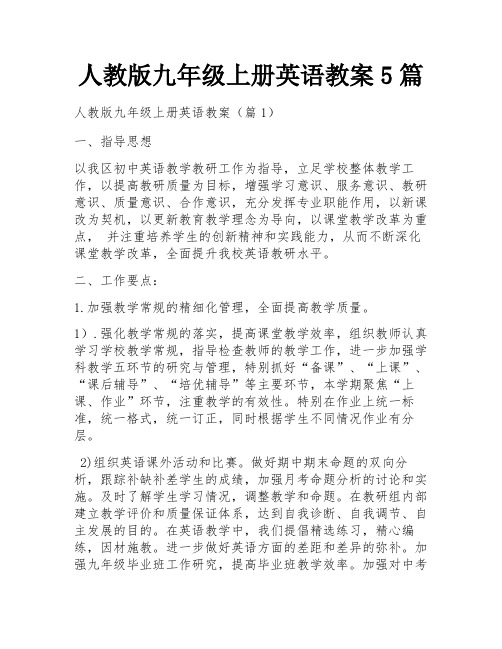
人教版九年级上册英语教案5篇人教版九年级上册英语教案(篇1)一、指导思想以我区初中英语教学教研工作为指导,立足学校整体教学工作,以提高教研质量为目标,增强学习意识、服务意识、教研意识、质量意识、合作意识,充分发挥专业职能作用,以新课改为契机,以更新教育教学理念为导向,以课堂教学改革为重点,并注重培养学生的创新精神和实践能力,从而不断深化课堂教学改革,全面提升我校英语教研水平。
二、工作要点:1.加强教学常规的精细化管理,全面提高教学质量。
1).强化教学常规的落实,提高课堂教学效率,组织教师认真学习学校教学常规,指导检查教师的教学工作,进一步加强学科教学五环节的研究与管理,特别抓好“备课”、“上课”、“课后辅导”、“培优辅导”等主要环节,本学期聚焦“上课、作业”环节,注重教学的有效性。
特别在作业上统一标准,统一格式,统一订正,同时根据学生不同情况作业有分层。
2)组织英语课外活动和比赛。
做好期中期末命题的双向分析,跟踪补缺补差学生的成绩,加强月考命题分析的讨论和实施。
及时了解学生学习情况,调整教学和命题。
在教研组内部建立教学评价和质量保证体系,达到自我诊断、自我调节、自主发展的目的。
在英语教学中,我们提倡精选练习,精心编练,因材施教。
进一步做好英语方面的差距和差异的弥补。
加强九年级毕业班工作研究,提高毕业班教学效率。
加强对中考走势的信息收集和测试研究,集中精力,争取在九年级中考中取得一个满意的成绩。
2.?以教科研引领,为教师的专业化成长打造新的平台。
1).大力开展校本教研,拓宽教师课程视野,逐渐成为学习型、反思型教师。
通过同伴互动。
充分发挥学校骨干教师、优秀教师的作用,通过“共享式的集体备课”、“探究式的课堂实践活动”和“专题式的学习讨论活动”等促进教师之间的互动,营造“集体备课、资源共享、个人加减、教后反思”的教研氛围。
结合优质课堂活动,并且推出一节具有代表性的研讨课。
(陈美红老师开课)2).根据各年级特点,进行一次主题教研活动。
2023新人教版九年级英语全一册教案【新版】

2023新人教版九年级英语全一册教案【新版】一、教学目标本课通过多种教学形式和活动,旨在帮助学生达到以下几个方面的教学目标:1. 提高学生的听、说、读、写能力;2. 培养学生的文化意识和国际视野;3. 培养学生的合作与沟通能力;4. 激发学生对英语研究的兴趣和自信心。
二、教学重点1. 研究并能正确运用本单元的重点词汇和短语;2. 通过听、说、读、写等多种方式,提高学生对单元话题的理解和运用能力;3. 培养学生在团队合作中互相帮助和倾听他人的能力。
三、教学内容本单元的教学内容主要包括以下几个方面:1. 单词和短语:根据教材内容和学生实际情况,选择合适的单词和短语进行研究;2. 句型和语法:通过各种练和活动,帮助学生掌握本单元的重点句型和语法知识;3. 阅读和写作:通过阅读材料和写作练,提高学生的阅读和写作能力;4. 听力和口语:通过听力材料和口语训练,提高学生的听力和口语表达能力。
四、教学方法1. 合作研究:通过小组活动、角色扮演等方式,培养学生的团队合作和互助精神;2. 任务型教学:通过设置任务和情景,激发学生的研究兴趣和动力;3. 多媒体辅助:利用多媒体资源,增加教学内容的生动性和趣味性;4. 情景教学:通过创设情境,使学生能够在真实的语言环境中练和运用所学知识。
五、教学步骤1. Warm-up (热身活动)在课程开始前,通过展示相关图片或视频引入话题,激发学生的兴趣和好奇心。
2. Presentation (新课呈现)通过教师的讲解和示范,介绍本单元的重点词汇、短语、句型等知识点,并通过例句和练来帮助学生理解和记忆。
3. Practice (练环节)通过口语练、听力练、阅读练等多种形式,让学生在实际的语境中运用所学知识,提高他们的语言技能。
4. Production (输出环节)让学生进行写作或口语表达活动,展示他们所学的知识和技能,鼓励他们自由表达和运用。
5. Consolidation (课堂巩固)通过小组讨论、游戏等活动,巩固学生对本课程内容的理解和掌握。
人教版九年级英语全册教案4篇
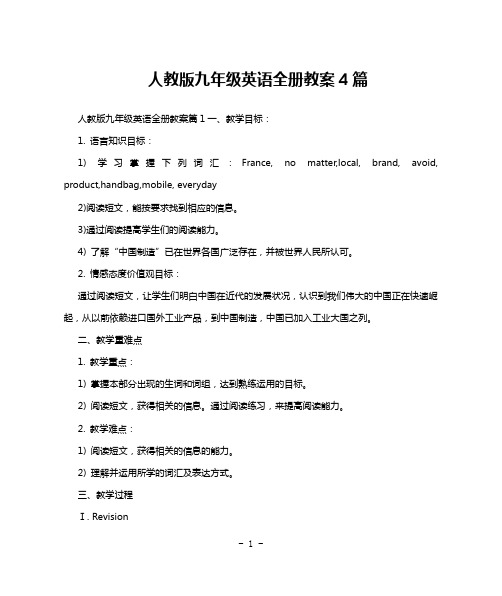
人教版九年级英语全册教案4篇人教版九年级英语全册教案篇1一、教学目标:1. 语言知识目标:1) 学习掌握下列词汇:France, no matter,local, brand, avoid, product,handbag,mobile, everyday2)阅读短文,能按要求找到相应的信息。
3)通过阅读提高学生们的阅读能力。
4) 了解“中国制造”已在世界各国广泛存在,并被世界人民所认可。
2. 情感态度价值观目标:通过阅读短文,让学生们明白中国在近代的发展状况,认识到我们伟大的中国正在快速崛起,从以前依赖进口国外工业产品,到中国制造,中国已加入工业大国之列。
二、教学重难点1. 教学重点:1) 掌握本部分出现的生词和词组,达到熟练运用的目标。
2) 阅读短文,获得相关的信息。
通过阅读练习,来提高阅读能力。
2. 教学难点:1) 阅读短文,获得相关的信息的能力。
2) 理解并运用所学的词汇及表达方式。
三、教学过程Ⅰ. Revision1. Ask Sstorole-play the conversation in 2d.2. Checkthehomework. Let some Ss tell read their sentences.(1). This ringismade of silver.(2). This kindofpaper is made from wood.(3). What ispaintmade from?(4). Hang Zhouisfamous for tea.(5). As far asIknow, tea plants are grown on the sides of the mountains.Ⅱ. Lead in1. 展示一段伦敦奥运会礼品的视频,让学生了解中国制造已被世界人民所接受。
Then ask Sssomequestions:T: As we know,thereare so many things made in China in England. What about in America andothercountries in the world? Now let’s read the passage of 3a.First, readquickly and find the answer to this question:1) Where did KangJianvisit last year?2) Were theremanythings made in China in the US?3) What twothingsdid Kang Jian want to buy in the US?4) Where weretheymade?Ss read thearticlequickly and try to answer the questions:2. 方法指导:带着问题,然后快速阅读短文,争取在较短的时间内,找到答案。
九年级英语教案模板人教版5篇

九年级英语教案模板人教版5篇九年级英语教案人教版1学习目标1.重点单词:repeat,note,pal,physics,chemistry,memorize,pattern2.重点短语:take notes,write in an English diary,using an English dictionary3.重点句式:—Do you learn English by reading aloud?—Yes,I do.It helps my pronunciation.—How can I improve my pronunciation?—One way is by listening to tapes.学习重点1.学习英语的方法2.How 对方式提问及用by+doing进行回答学习难点1.学习英语的方法2.How 对方式提问及用by+doing进行回答自主学习一、预习课本P4新单词并背诵,完成下面的汉译英。
1.重复________2.笔记________3.朋友________4.物理________5.化学________6.模式________二、认真预习Grammar Focus-4c找出下列短语和句型。
1.做笔记2.写英语日记3.使用字典4.—你通过大声朗读来学习英语吗?—是的,它对我的发音有帮助。
5.—我怎么能提高我的发音?—一个方法就是听录音。
课堂导学Step 1情景导入Teacher:How do you study English?Student1:I study English by working with friends.Teacher:How do you study for an English test?Student2: I study for anEnglish test by asking the teacher for help....环节说明:通过师生互动问答,对前两节课所学的重要的句型和短语进行了复习。
人教版九年级上册英语教案(优秀8篇)

人教版九年级上册英语教案(优秀8篇)作为一位兢兢业业的人民教师,总归要知道如何编写一份优秀的教案。
这次为您整理了8篇《人教版九年级上册英语教案》,亲的肯定与分享是对我们最大的鼓励。
九年级上册英语教案篇一一、教学内容本课是第二单元的最后一课,阅读课,是本单元话题过去的某种状态的延伸和继续。
文章讲得主要内容是一个老是惹麻烦的男孩在明白了母亲对他的爱之后变成一个好孩子的故事。
二、教学目标⑴掌握一些主要的词汇和句型used to be like 等。
⑴引导学生理解课文内容,掌握阅读技巧,如扫读、细读、概括文章大意,利用上下文信息猜词等。
⑴通过阅读课文,并设计各种活动训练学生运用英语进行听说读写各种活动的能力。
⑴激发学生感恩父母,热爱父母,关注身边的人的情感。
三、教学重点和难点⑴训练学生利用上下文信息填写词汇和句子的能力。
⑴培养学生的阅读策略和写作能力。
⑴利用本课所学知识表达个人意见,对课文进行深层理解。
四、设计理念依据纽南(David Nunan)所提出的任务型及合作式教学原则,使学生在小组学习中获取信息,处理信息和运用信息,激发学生用所学语言进行交际的愿望和自信心,促进合作精神和文化意识的发展。
五、教学设计1. 总体思路:本节课是在多媒体的课堂教学环境下实施的大容量、快节奏的课堂教学。
笔者先让学生简短描述父母以前和现在的职业,外貌,性格,爱好再欣赏英文歌曲thank you, dad. 导入,酝酿了一种感激父母的氛围,接着引导他们畅诉父母对自己的帮助的故事,然后让学生阅读短文,感受母亲爱的伟大。
在阅读过程中,通过让学生看标题,预测课文内容、概括文章段落大意、根据上下文填所缺的句子,判断正误等各种方式提高阅读技能。
最后,笔者提供关键词让学生复述课文,使其能熟练得掌握所学的重点词汇、短语和句子。
阅读后,笔者抛出这样的问题让学生讨论:我们该用什么方式报答父母?培养学生反哺意识。
最后通过写作,提高学生综合运用语言的能力。
最新人教版九年级英语上册教案(全册)
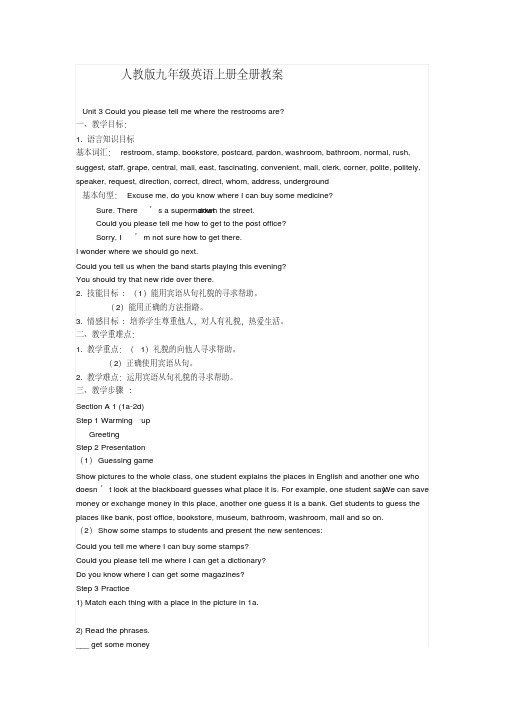
人教版九年级英语上册全册教案Unit 3 Could you please tell me where the restrooms are?一、教学目标:1. 语言知识目标基本词汇:restroom, stamp, bookstore, postcard, pardon, washroom, bathroom, normal, rush, suggest, staff, grape, central, mail, east, fascinating, convenient, mall, clerk, corner, polite, politely, speaker, request, direction, correct, direct, whom, address, underground基本句型:Excuse me, do you know where I can buy some medicine?down the street.Sure. There’s a supermarketCould you please tell me how to get to the post office?Sorry, I’m not sure how to get there.I wonder where we should go next.Could you tell us when the band starts playing this evening?You should try that new ride over there.2. 技能目标: (1)能用宾语从句礼貌的寻求帮助。
(2)能用正确的方法指路。
3. 情感目标: 培养学生尊重他人,对人有礼貌,热爱生活。
二、教学重难点:1. 教学重点:(1)礼貌的向他人寻求帮助。
(2)正确使用宾语从句。
2. 教学难点:运用宾语从句礼貌的寻求帮助。
三、教学步骤:Section A 1 (1a-2d)Step 1 Warming –upGreetingStep 2 Presentation(1)Guessing gameShow pictures to the whole class, one student explains the places in English and another one who doesn’t look at the blackboard guesses what place it is. For example, one student say: We can save money or exchange money in this place, another one guess it is a bank. Get students to guess the places like bank, post office, bookstore, museum, bathroom, washroom, mall and so on.(2)Show some stamps to students and present the new sentences:Could you tell me where I can buy some stamps?Could you please tell me where I can get a dictionary?Do you know where I can get some magazines?Step 3 Practice1) Match each thing with a place in the picture in 1a.2) Read the phrases.___ get some money___ get some magazines___ have dinner___ get a dictionary___ get some information about the town___ buy a newspaper___ buy some stamps___ get a pair of shoesStep 4 ListeningListen and complete the conversations in the picture in 1a. Then check the answers with the whole class.Step 5 PracticeMake conversations using the information in 1a. Then talk about your own city. For example:A: Excuse me, could you please tell me how to get to the bookstore?B: Sure, just go along Main Street until you pass Center Street. The bookstore is on your right, beside the bank.A: Thanks. Do you know when the bookstore closes today?B: It closes at 7:00 p.m. today.A: Thank you!B: You’re welcome.Step 6 Listening1. Listen and number the directions in the order that you hear them.2a You will hear some of the directions below. Number the directions in the order you hear them. ___ Go to the bird floor.___ Turn left.___ Go to the second floor.___ Turn right.___ The supermarket is between the flower store and the bookstore.___ Go past the bookstore.2. Listen again. Show how the boy walks to the supermarket. Draw a line in the picture in 2a. Then get one student draw the line on the blackboard.3. Listen the third time and answer the questions.1) Excuse me, can you tell me where I can buy some medicine?2) Do you know how to go there?3) OK, great. Oh, and one more thing. Do you know when this shopping center closes tonight?4) OK, thanks a lot.Step 7 PairworkMake conversations about the other places in the picture in 2a.A: Excuse me. Can you tell me where I can buy some stamps?B: Yes, there’s a post office in this shopping center.A: Do you know how to go there?B: Yes. Go to the third floor and turn right. Then go past the bank. The post office is betweenmuseum and library. You should be able to get stamps.A: OK, great. Oh, and one more thing. Do you know …B: I’m not sure, but you …A: OK, thanks a lot.B: You’re welcome.Step 8 Reading1. Read the conversation in 2d and answer the questions.2. Role – play the conversation.3. Explain the language pints in 2d.(1) Go along Main Street until you pass Center Street.1) until和till同义为“直到……” ,till多用于口语,until可以放在句首,till则不能放在句首。
九年级英语教案
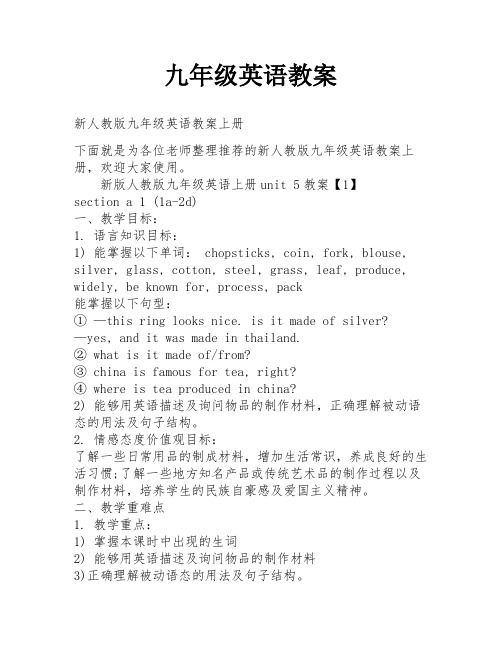
九年级英语教案新人教版九年级英语教案上册下面就是为各位老师整理推荐的新人教版九年级英语教案上册,欢迎大家使用。
新版人教版九年级英语上册unit 5教案【1】section a 1 (1a-2d)一、教学目标:1. 语言知识目标:1) 能掌握以下单词: chopsticks, coin, fork, blouse, silver, glass, cotton, steel, grass, leaf, produce, widely, be known for, process, pack能掌握以下句型:① —this ring looks nice. is it made of silver? —yes, and it was made in thailand.② what is it made of/from?③ china is famous for tea, right?④ where is tea produced in china?2) 能够用英语描述及询问物品的制作材料,正确理解被动语态的用法及句子结构。
2. 情感态度价值观目标:了解一些日常用品的制成材料,增加生活常识,养成良好的生活习惯;了解一些地方知名产品或传统艺术品的制作过程以及制作材料,培养学生的民族自豪感及爱国主义精神。
二、教学重难点1. 教学重点:1) 掌握本课时中出现的生词2) 能够用英语描述及询问物品的制作材料3)正确理解被动语态的用法及句子结构。
2. 教学难点:理解被动语态的用法及句子结构。
三、教学过程ⅰ. lead in1. 播放动画片《造纸过程》的视频,让学生们了解这个中国传统发明的情况。
t: who invented paper first?s1: can lun invented it in han dynasty.t: what was paper made of then?s2: it was mainly made of bamboo.t: was it easy for people to make paper then?s1: no, it was very difficult then.t: what is paper made of now?s3: it’s mainly made of wood, bamboo, and cotton.…ⅱ. presentation1. present the sentence structure, using the pictures on the big screen:—what’s the golden medal made of?—it’s made of gold.—is this table made of wood?—no, it isn’t. it’s made of glass.—is butter made from meat?—no. it’s made from cream?让学生们学习掌握be made of/from句型的用法,及be made of与be made from的区别。
新人教版初中英语九年级全册精品教案

新人教版初中英语九年级全册精品教案(共180页)--本页仅作为文档封面,使用时请直接删除即可----内页可以根据需求调整合适字体及大小--Unit 1How can we become good learners? Language Goal【语言目标】Talk about how to study Knowledge Goals【知识目标】Key Wordstextbook,conversation,aloud,pronunciation,sentence,patient,expression,discover,secret,grammar,repeat,note,physics,chemistry,pronounce,increase,speed,partner,born,ability,create,brain,active,attention,connect,review,knowledge,wiselyKey Phrases look up,ask help,fall in love with,be born with,payattention to,connect…withKey Sentences1.—How do you learn English?—I learn by studying with a group. 2.—Do you learn English by reading aloud?—Yes,I helps my pronunciation.3.—How can I read faster?—You can read faster by reading word groups. 4.—How can I improve my pronunciation?—One way is by listening to tapes.Key Grammar Learn to use “verb+by doing(gerund)” to express ways ofdoing things.Ability Goals 【能力目标】listening,speaking,reading and writing skills by usingthe target languages.2.Learn to talk about ways of studying,give suggestions to help others overcome their obstacles in study and discuss how to learn better using “by doing sth.”.Moral Goals 【情感目标】 the help of this unit's study,students can think and learn how to study English and they will be encouraged to be active and hard-working learners. 2.Learn to communicate and cooperate with others instudy.Teaching Time【课时】Five periodsPeriod 1Section A(1a-2d) Period 2Section A(3a-4c) Period 3Section B(1a-1e)Period 4Section B(2a-2e)Period 5Section B(3a-3b) & Self Check本单元围绕学习的话题,讲述了学习的障碍及对应的解决方法,对学生的学习有重要意义。
人教版九年级英语全册教案4篇

人教版九年级英语全册教案4篇人教版九年级英语全册教案篇1一、教学目标:1. 语言知识目标:1)掌握本单元基础知识,掌握过去完成时的结构和用法。
2)能够根据所学知识进行写作,提高学生的写作能力。
2. 情感态度价值观目标:二、教学重难点过去完成时的用法三、教学过程Ⅰ. Warming up and revision1. Have adictationof the new words and expressions this unit.2. Retellthestories of April Fool’s Day .根据句意,用括号内所给动词的适当形式填空。
1) By the endoflast year, I ___________ (be) to the West Hill Farm three times.2) By the time Igotup, Mom _________ (go) out for some exercise.3)I______________(learn) 1,000 English words by last term.4) By 9 o’clocklastnight, we __________ (get) 200 pictures from the spaceship.5) When I wentintothe classroom, the final bell ___________ (ring).I was happy that Iwasn’tlate.Keys: hadbeenhadgonehad learnedhad gottenhad rung根据句意和汉语提示,填写恰当的短语完成下列句子。
1) He ___________(醒来) very early and went out for a walk inthepark.2) I______________(让她搭便车), so she invitedme to have dinner.3) I hope thatallof you will come to the meeting ____________ (准时).4) Hiscar___________ (出故障), so he had to getit repaired.5) This Mondaymyalarm clock didn’t __________ (发出响声) and I got uplate.Keys: woke up gave her a lifton timebroke downgo offⅡ. Lead-inDo you haveanyexperience on April Fool’s day? Now can youremember a lucky or an unlucky day?What happened? Make some notes about whatyou remember.III. Practice.1. Work on 3a.Makenotes.Can you rememberalucky or an unlucky day? What happened? Make some notes about whatyouremember.What was thedate?What happenedfirst?Was this luckyorunlucky? Why?Whathappenednext?How did thedayend?How did youfeelabout this day?2. Share yourideaswith others in class.IV. Writing1. Write astoryabout your lucky or unlucky day and tell your story to a partner or e your notes to write a story about your lucky or unlucky day.写作指导:常见的表达句型:My lucky/unlucky dayI willalwaysremember the date…This wastheluckiest /unluckiest day of my life…When I woke upthatmorning…Later that day…I couldn’tbelieve…Then/After that…Finally…I think….What alucky/anunlucky day!2. Ask Ss to writeapassage in class.3. Tell yourstoryto your partner or the class.Example:My lucky dayI willalwaysremember the date –April Fool’s Day last year.This wastheluckiest day of my life.When I woke upthatmorning, I brushed my teeth, washed my face, then I read English for halfanhour. It was time to eat my breakfast. My little brother gave me a pieceofOreo. I was very glad to eat it first. Then I felt strange. It tastedspecial.What was it? I looked at my little brother. He laughed loudly and saidnothing.Later that day,Iknew he put toothpaste (牙膏) into the Oreo. Icouldn’t believe I wasfooled by him. I brushed my teethagain. After that, my brother gave me a box ofOreo, and said “Happy April Fool’s Day.”Finally I washappyto get these delicious biscuits.I think I hadahappy and lucky day.What a lucky day!V. Self-check.Work on SelfCheck1:1. Let some Ssreadthe words in the box. Make sure all the Ss know the meaning of the words.2. Let Ss readthesentences in Self check 1. Then Ss try to fill in the blanks with thecorrectforms of the words in the box.cancelmiss west accidentladyofficermarketunexpectedLast Saturdayaftermy French course, I decided to drive to the ________ to buy a meat piefordinner. As I was heading ________, I saw a huge truck in the middle of theroad.There had beena(n)_________ and there were many police _______ around.I turned around anddecidedto go to a nearby mall.However, I________the road that led to the mall. Then I saw a restaurant that soldchickennoodles. I went inside and the _____, who was the owner, served me themostdelicious bowl of chicken noodles ever. I had made a(n) ____________discovery!I’mso glad that I _________ my plan to go to the market.1. Letsome Ss read their answers. Check theanswers with the Ss.Keys: market west accident officersmissedlady unexpected canceled Work on Self check21. Tell Ss thattheyhave to fill in the blanks with Past Perfect Tense. More than one answersmay bepossible.2. Ss think andtryto complete the sentences by themselves.3. Let some Ssreadtheir answers to the class.4. Sharetheiranswers together.e.g.1) A: Why didn’tyouhand in your science homework?B: Before Icould start working on it, mybaby brother started crying and I had to lookafter him as my mother was sick.2) A: Why didn’tyoutake a shower this morning?B: By the time Igotup, my sister had already gone into the bathroom and the bus was honkingfor meto hurry up.3) A: Why didyou have to walk home from school?B: By the timeIleft my school, the school bus had already left.VI. Exercise1. We ______fourthousand new words by the end of last year.A. learnedB.had learnedC. have learnedD.willlearn2. He told usthathe ______ the letters in the morning.A. willpostB.havepostedC. waspostingD. had posted3. —Did you seeMr Smith when you were in France?—No. When I_______ France, he _______ to China.A. had arrivedin;had goneB. arrived in;hasbeenC. got to;hadgoneD. had got to;hadbeenVII. Homework1. 复习本单元内容。
- 1、下载文档前请自行甄别文档内容的完整性,平台不提供额外的编辑、内容补充、找答案等附加服务。
- 2、"仅部分预览"的文档,不可在线预览部分如存在完整性等问题,可反馈申请退款(可完整预览的文档不适用该条件!)。
- 3、如文档侵犯您的权益,请联系客服反馈,我们会尽快为您处理(人工客服工作时间:9:00-18:30)。
掌握短语send out 释放 be covered with 被…覆盖
阅读含有一般现在时态的被动语态课文并理解课文
Keyand difficultpoints
掌握单词1.formn.形式,类型;2. livelyadj. 生气勃勃的;
2. Ask some of them to answer .
Discuss the questions in groups and speak out.
To give students the chance toexpress their own ideas..
Step9
homework
1.Go over thepassage
5.After reading the whole passage ask them to answer the last question in 2c
Readthe passage andanswerthe questions in 2c.
To help studentsimprove problem soห้องสมุดไป่ตู้ving and analytical skills
3. heatn.热,高温;v. 加热,变热;4. completev. 完成;
掌握短语send out 释放 be covered with 被…覆盖
Teaching methods
Task-based
Teaching means
Multi-media, recorder
Teachingprocess
Chapter and Section
Unit5 What are the shirts made of?
SectionB(2a—2e)
Teacher
李华峰
Topic
Talk aboutfolk and traditional art inChina
Type
Reading
Teaching
goals
掌握单词1.formn.形式,类型;2. livelyadj. 生气勃勃的;
4.in trouble陷入困境
5. be covered with 被…覆盖
6.fire at a very high heat 在高温下烧烤
2.Read the passage again and do activity 2d
3.Check the answers.
Finishthe exercises
To give studentswritingpractice with thetarget language
Step 6
Listening
Listen to the tape and draw themind map
Step7
Summary
Summarize what we have learned today.
Listen and think
To lead to the group work.
Step8
Group work
1.Let studentsdiscuss the questions in 2e
Step 4
Key points
Present the key and difficult points to students
Listen andtake notes
To help students understand the passage well.
Step5.Exercises
1.According to the key points to do some exercises
2.Askstudentsto read the second paragraph and answer the question 2 in 2c.
3.Havestudentsread thethirdparagraph and answer the questions3, 4in 2c.
4.Askstudentstoread the fourth paragraph and answer the question 5 in 2c.
2.Do the exercise book
Blackboard design
Unit5What are the shirts made of?
SectionB(2a—2e)?
1.turn into转变变成
2. according to Chinese history 根据中国历史
3. send out 释放 \
Listen and answer my question!
Talk about other folk and traditional art inChina
To make the students be interested in today’s topic
Step 2
Presentation
Ask students to read the passage in 2b by themselves. And try to fill in the chart below
The teacher’s activities
The students’ activities
Purpose
Step 1
Lead-in
Greet the students. Ask themto look at some pictures of folk and traditional art inChinaand ask them what other folk and traditional art inChinado they knowto lead to the target language.
Read the passage in 2b And fill in the chart below.
To help studentsimprove their reading skills.
Step 3
Intensive reading
1.Have studentsread the first paragraph and answer the question 1 in 2c.
